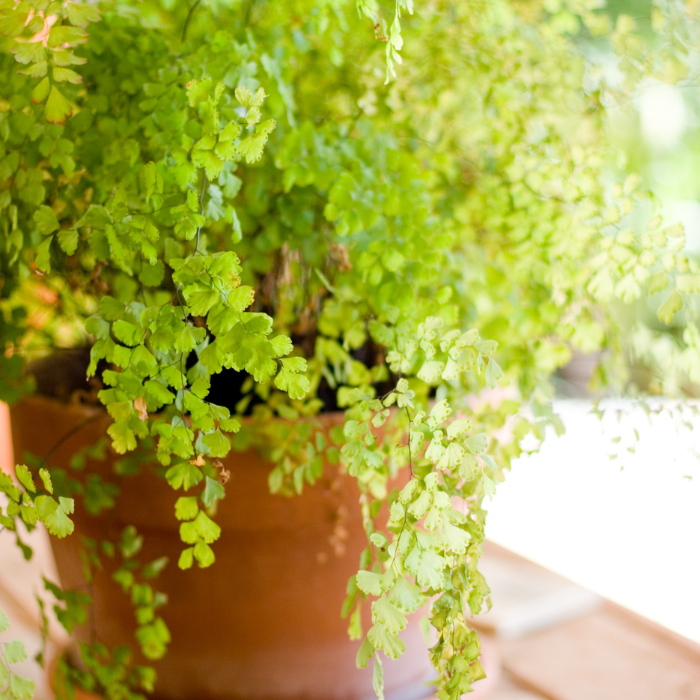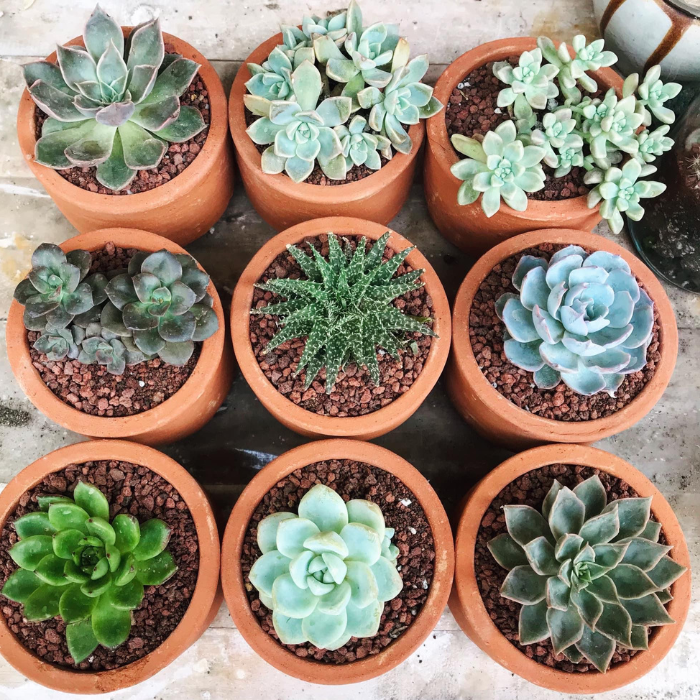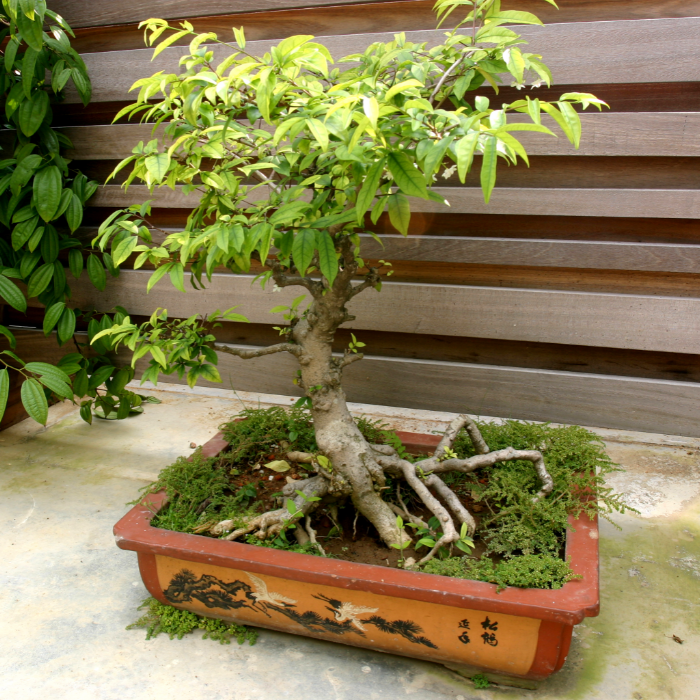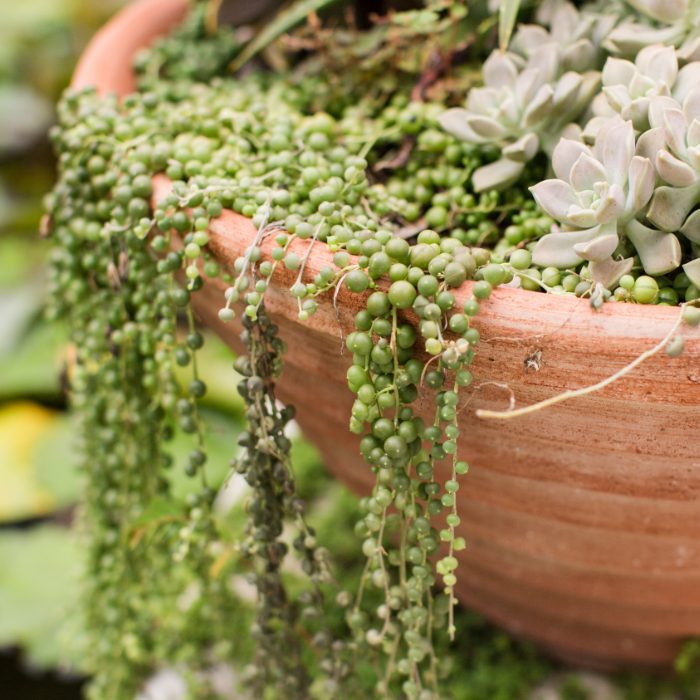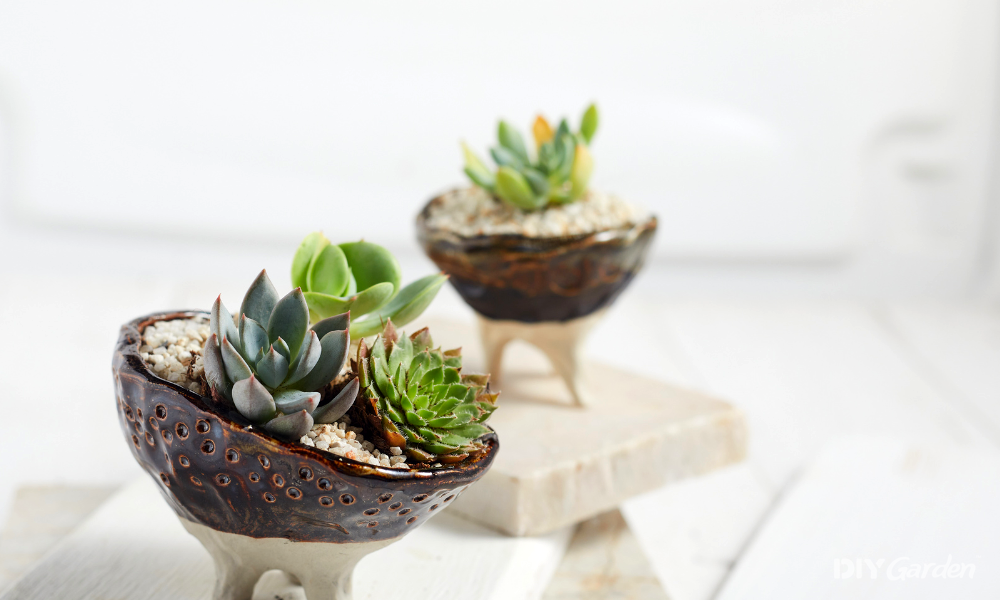
Shallow pots are underrated. Not only do they create an interesting height difference when you sit them alongside deeper pots, but they’re also much easier to move due to their compact size.
And if that weren’t enough, shallow pots are perfect for plants needing good drainage, as water is less likely to accumulate, reducing the risk of root rot!
So, shallow containers have obvious benefits.
But what plants actually like growing in them? In this article, we share the 17 best plants for shallow pots. Enjoy!
Indoor Plants for Shallow Planters
1. Maidenhair Fern
If you’re looking for a plant with a delicate, calming appearance, the maidenhair fern may be right up your street.
Sporting dainty leaves on thin black stems, this fern species has a different appearance from your typical fern.
The maidenhair fern typically grows between tight spots like rock fissures, making it a prime candidate for small pots.
2. Pincushion Cactus
The pincushion cactus definitely falls within the small plants category.
It has a compact, globular shape that resembles a pincushion – hence the name!
However, if you’re ruling this one out because of its size, think again!
What the pincushion cactus lacks in size, it makes up for in personality.
It’s a good option if you love plants but only have a small space to house them.
3. Succulents
Succulents can be really slow-growing plants, making them a great choice if you don’t have a lot of space for indoor plants.
Some of the most popular succulents that prefer shallow soil are haworthias (such as the zebra plant), sempervivums (such as hens & chickens), and living stones.
Most succulents love full sun, so pop them in a bright, sunny window.
4. Snake Plant
A snake plant (also known as “Sansevieria”) can be a great option if you’re new to looking after plants.
Snake plants are hardy, low-maintenance plants that require very little care.
They don’t mind their sunlight conditions, growing well in direct sunlight, indirect sunlight, or even shade!
And, in winter, they may only need watering once every two months!
READ NEXT: Types of Sansevieria Plants (A Comprehensive Guide)
5. Bonsai Trees
In contrast to the hardy snake plant, bonsai trees aren’t for the faint-hearted.
This small tree requires proper care, making it harder to keep alive.
But the bonsai is so worth it if you can get its care down to a T! Bonsai trees prefer a shallow, wide pot, such as a shallow dish.
Wider pots help constrict the bonsai’s roots, helping it maintain its characteristic shape and size.
6. Prayer Plants
The prayer plant, also known as Maranta leuconeura, is a shade-loving plant that thrives in indirect sunlight or full shade.
It’s a lovely plant that’s highly popular as a houseplant due to its green leaves with striking red veins.
You may be wondering where the name “prayer plant” originates from.
Well, prayer plants move throughout the day, with their leaves lowering during the day and raising overnight, giving the impression of prayer hands.
7. Aloe Vera Plant
Aloe vera is a houseplant (or outdoor plant!) with extreme visual appeal. Its spiky leaves are fleshy and plump with serrated edges.
These allow it to retain water, which helps it to survive in its original habitat – arid areas of the world like Africa, the Arabian Peninsula, and Madagascar.
But that’s not all aloe vera has going for it, oh no.
Aloe vera’s sap also has medicinal properties, helping to soothe skin irritations, insect bites, burns, sunburn, and scalds.
8. Pinstripe Plant
The pinstripe plant, or “Calathea ornata,” is a member of the prayer plant family, so it has a similar appearance.
However, while it sports the same verdant green leaves with pinky veins, its leaves are pointed rather than curved.
The pinstripe plant can be pretty particular about its growing conditions.
So, to ensure your plant thrives, place it in a spot with bright, indirect light (definitely not direct sun!), and regularly mist it to keep it humid.
9. String of Pearls
String of pearls is one of the most popular trailing houseplants due to its gorgeous pearl-shaped beads that dangle down from its central stem.
This plant is a fast-grower, meaning you can have string of pearl plants filling your house before you know it!
String of pearls plants have shallow roots, allowing you to keep them in shallow containers.
Because of this, they only require watering when their soil is completely dry. They really don’t like to sit in water, so bear that in mind!
Edible Shallow-Rooted Plants
10. Leafy Greens
Despite popular belief, many leafy greens don’t need soil in abundance to produce a delicious treat!
For example, Swiss chard, spinach and lettuce all grow well in shallow containers.
Swiss chard needs a container 8 inches deep at a maximum, spinach can handle as shallow as 6 inches, and lettuce even shallower than this – 4 – 6 inches!
11. Root Vegetables
There are so many benefits of growing root veg in containers – for one, you can move pots around easily, making them highly versatile.
And secondly, they’re more accessible if you’ve got limited garden space!
Some root vegetables that make excellent potted plants in shallow containers are onions, radishes, and garlic.
Plant onions and radishes in pots with a depth of 4 – 6 inches, and give garlic 6 inches of soil to spread out in.
12. Fragrant Herb Plants
Most (if not all!) of us use herbs in our cooking, so why not have them in pots?
The great thing about many herb plants is that they can grow in shallow containers.
One popular herb that all of us know and love is mint.
Within the mint family are many shallow-rooted plants like rosemary, oregano, basil, and sage.
However, before whacking your herbs in any ol’ pot, just know that herbs need air circulation and don’t like to sit in excess water, so ensure their shallow containers have drainage holes!
READ NEXT: How to Create a Raised Bed Herb Garden
Annual Plants With Shallow Root Systems
13. Zinnias
Although zinnias flower and die within one season, the spectacular show they put on when in bloom makes these plants genuinely worth the hype.
Plus, because they only live for a year, their roots only extend to 12 – 24 inches, so shallow pots are great for these!
Zinnias are available in a multitude of colours, from green to red to a deep pink; you’re bound to find a variety you like the look of!
14. Marigolds
If you want a show-stopping plant, look no further!
The striking contrast between the marigold’s vibrant yellow and rust-red blooms and dark green leaves will brighten up any garden!
Growing well in 6-inch containers, all marigolds need is either full or part sun and a thorough watering when the top inch of soil is dry.
But don’t water them any old way – it’s important to remember to water the base of the plant, not overhead. Otherwise, you’ll encourage powdery mildew!
Perennial Plants With Shallow Roots
15. African Violets
People love African violets for their eye-catching flowers that can sport various shades, from mauve to red to a deep blue-purple.
These plants originate from the Tanzanian rainforests, so they don’t do well outdoors.
So, find a nice sunny spot with direct light and humid air to keep your African violets happy.
One of the most popular relatives of the African violet is the flame violet. As the name may suggest, this plant shows off vibrant red flowers and attractive multi-coloured leaves.
16. Pansies
If you want a plant with personality, you can’t beat pansies.
They’re bright and incredibly charismatic – just look at those upturned faces!
As you can see, pansies will fit in just about any pot. But if you go for old China teacups like in this design, you’ll need to add a drainage hole or two to the bottom, as pansies prefer free-draining soil!
17. Petunias
Are you ready for another British garden favourite? Petunias are a wonderful addition to any garden.
You’ll likely see them popping up in hanging baskets and containers in the warmer months, as they produce an abundance of flowers from June right through to October.
You may be surprised that petunias are showing up as perennial, but they are actually perennial plants.
However, we most often grow them as annuals from seed each year!
The most popular petunia cultivar for a container garden is the Multiflora petunia due to the compact, mounding shape it forms.
If you enjoyed this article, you’ll love our Foolproof Guide to Container Gardening. Check it out now!
